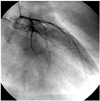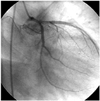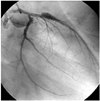Introduction
Coronary artery aneurysm is defined as an area of localized coronary artery dilatation with a diameter 1.5 times greater than an adjacent normal reference segment of vessels.1) Cases of coronary artery aneurysm formation after coronary angioplasty, directed coronary atherectomy and laser angioplasty have been reported with a frequency of 2% to 10%.2) However, the rate of aneurysm formation after implantation of a drug-eluting stent has not yet been reported.
Case
A 26-year-old male was admitted to the hospital after experiencing precordial chest pain for 5 months. The chest pain was exercise-induced, lasted for one minute and regressed spontaneously. He had no history of cardiac disease.
Upon physical examination, he was afebrile with a blood pressure of 120/70 mmHg, a heart rate of 70 beats/min and a respiratory rate of 20 breaths/min. His heart sounds were regular without gallops, murmurs or rubs. Laboratory findings including CK-MB and TnT fell within the normal range. Initial electrocardiography showed a sinus tachycardia. The left ventricular ejection fraction, as determined by echocardiography, was 78% without wall motion abnormality.
Diagnostic coronary angiography revealed significant stenosis at the middle third of the left anterior descending artery and proximal circumflex artery(Fig. 1). After predilation using a balloon catheter(2×15 mm, 6 atm), a 3.0×23 mm CYPHER®(Johnson & Johnson-Cordis, Florida, USA) stent was implanted at the left anterior descending artery and a 3.0×18 mm CYPHER® stent was implanted at the proximal circumflex artery using a semi-compliant balloon catheter (3.0×10 mm, 12 atm) (Fig. 2).
During his hospital stay, the patient improved without precordial pain. There were no electrocardiographic or enzymatic alterations observed. Two days after stent implantation, he was discharged with a prescription for 75 mg/day of clopidogrel and 100 mg/day of aspirin.
Eight months after implantation of the sirolimuseluting stents the patient underwent a follow-up coronary angiography, which disclosed the presence of coronary artery aneurysms at the intrastent proximal portion without restenosis(Fig. 3). Because the patient exhibited no specific symptoms during the 8 month follow-up period, no further evaluation or management was attempted.
Discussion
It has been reported that drug-eluting stents decrease the rate of restenosis by inhibition of vascular smooth muscle cell proliferation.6)7) The effect of Sirolimus occurs during the G1 cycle of cell proliferation and includes prohibiting cell proliferation, promoting cell death and decreasing inflammatory reaction.8) Therefore, the drug-eluting stent has a possibility of causing an aneurysm at the adjacent coronary vessels if stent malapposition occurs.9)
Recently, 13 patients with incomplete stent apposition were evaluated by intravascular ultrasound(IVUS) six to twelve months after sirolimus-eluting stent implantation. It was observed that the area of incomplete apposition did not show alterations except in one patient, in whom a coronary artery aneurysm was detected. Because sirolimus elution from the stent struts continues for only six weeks and sirolimus has a halflife of 60 hours, it is unlikely that sirolimus itself can induce long-term effects on the vessel wall. For this reason, Degertekin, et al.3) suspected that this aneurysm was preexisting at the time of stent implantation, but had been masked by a thrombus.3)
In addition to incomplete stent apposition, causes of intracoronary stent-related aneurysm formation can also be explained by balloon dilatation over 12 atm,10) localized hypersensitivity vasculitis4) or coronary artery vasculitis due to reaction with the polymer of the stent.5) However, the mechanisms by which these conditions cause aneurysms have not been satisfactorily explained to date.
A limitation of this report is that IVUS was not performed. IVUS is the most accurate diagnostic tool for assessing both the interrelationship between stent location and vessel wall as well as the characteristics of the aneurysm, therefore we recommend mandatory IVUS in evaluation of such cases.
The clinical course of coronary artery aneurysms not related to a stent varies from asymptomatic to angina pectoris or acute myocardial infarction.11) Therefore, it is clear that the application of a graft stent12)13) or surgical repair14) is helpful. However, there is no evidence linking stent-related coronary artery aneurysm with an increased mortality rate, acute myocardial infarction or coronary artery rupture. In this case, because the patient has not complained of any specific symptoms or exhibited specific signs, further evaluation and treatment was not performed.
We suggest that interventional cardiologists consider a coronary artery aneurysm could be anticipated after drug-eluting stent implantation. We need to observe this case closely with a long term follow-up period to determine the clinical course of coronary artery aneurysms developed after drug-eluting stent implantation.




 PDF
PDF ePub
ePub Citation
Citation Print
Print





 XML Download
XML Download